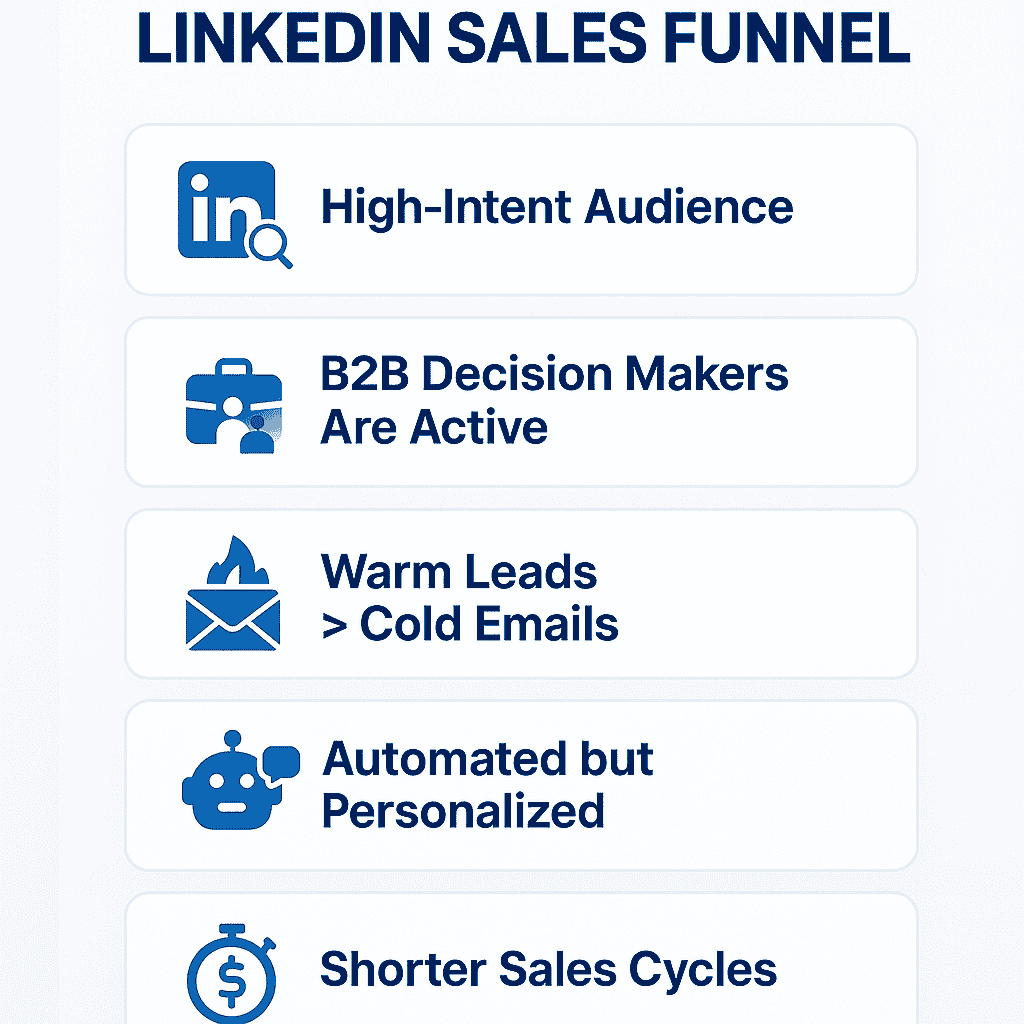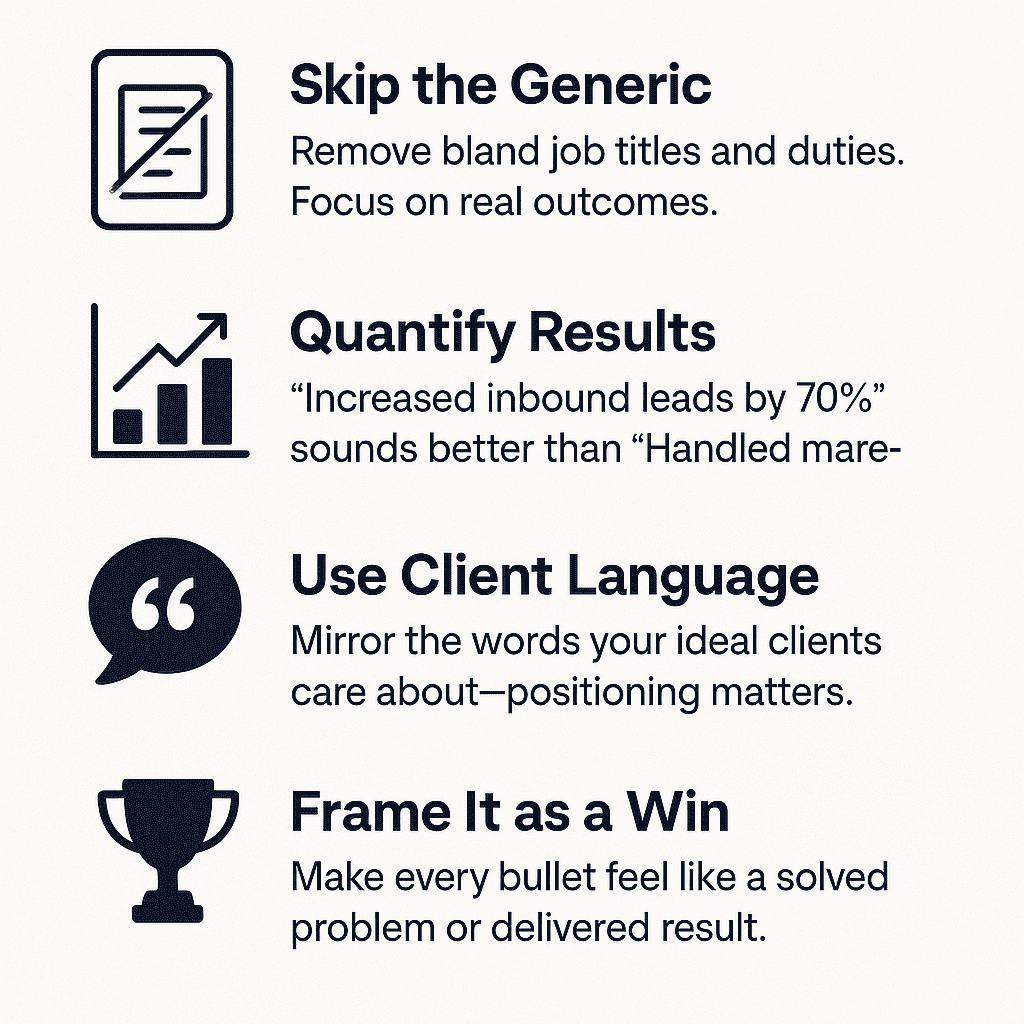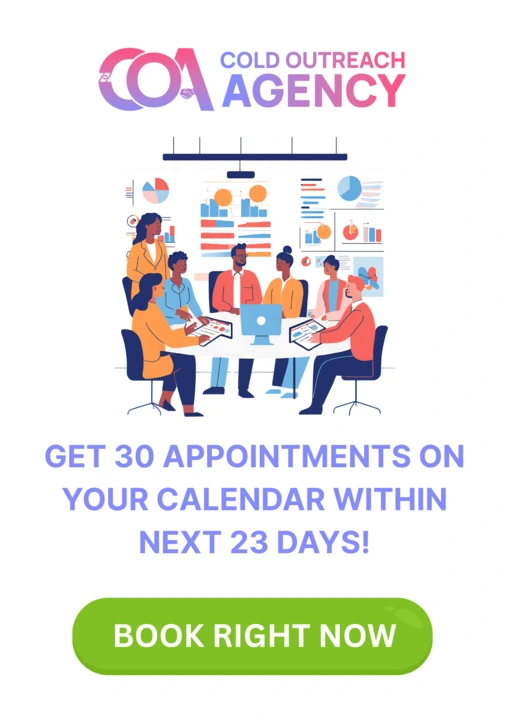Let’s face it— cold outreach agency. LinkedIn isn’t just a résumé or a digital business card anymore. For SaaS founders like you and me, it’s one of the most powerful and untapped sales funnels available today. Most people use it to look professional or connect with colleagues, but if you approach it strategically, LinkedIn becomes a lead-generating machine—running 24/7, even when you’re not.
I’ve spent years building, testing, optimizing, and refining my LinkedIn presence—not for vanity metrics, but to drive high-quality inbound leads, book calls, and close deals. In this post, I’m going to show you exactly how I optimized my LinkedIn profile as a sales funnel, and how you can do it too.
Why SaaS Founders Need a LinkedIn Sales Funnel

If you’re a SaaS founder, you probably already know that cold outreach has its limits. Ads get expensive. SEO takes time. But LinkedIn gives you something unique: visibility to a warm, targeted audience that’s already in business mode.
When your profile is optimized correctly, it becomes a magnet. Prospects visit, get value, and self-qualify—before they ever book a call. You reduce friction, increase trust, and most importantly, convert more consistently.
Step 1: Optimize the Profile Banner
I designed a custom banner with:
- My value proposition (again)
- A visual or logo of my SaaS product
Step 2: Rewrite the “About” Section as a Sales Letter
The “About” section is where most people either brag or bore their visitors to death. What I did instead was write it like a mini sales letter.
- I drop some relevant experience or social proof.
- Value: I explain exactly how I help and what results I deliver.
- CTA: I finish strong with a call-to-action (e.g., “DM me ‘growth’ to chat,” or “Click below to book a free discovery call.”)
The Featured section is gold. It’s where I send people to my key assets:
- A link to my SaaS product’s landing page
- A case study or client testimonial video
- A Calendly link for free consultations or demos
- A lead magnet like a downloadable PDF or free SaaS growth checklist
This is where you make it easy for people to take the next step without scrolling too far.
Pro tip: Use thumbnails that look like buttons—“Download Now,” “Watch the Demo,” “See Real Results.” It boosts clicks significantly.
Step 3: Transform Your Experience Section into Proof Points

Instead of listing out job duties like a traditional CV, I used each experience section to reinforce the transformation I helped create.
For my current role, I structured it like a client story:
- What problem I help solve
- How my SaaS or consulting process works
- The kind of results I’ve helped clients achieve
- A clear CTA with a booking link
Each job entry becomes a case study. Even my past roles are reframed in terms of the impact I had, especially if they’re relevant to my SaaS niche.
Step 4: Get Strategic With Skills & Recommendations
Here’s a hack: add skills that match what your ICP is looking for (e.g., “SaaS Growth Strategy,” “Sales Funnel Design,” “B2B Demand Generation”).
Then, ask satisfied clients or users to endorse those skills or leave recommendations that speak directly to those capabilities.
I even give them a short script to make it easier: And the best way to do that on LinkedIn? Content.
And yes, I repurpose content—what worked in an email or webinar usually works on LinkedIn too.
Step 5: Use the DM Inbox Like a Funnel
When someone connects or engages, don’t just say “Thanks for connecting.” That’s a dead end.
I have a warm follow-up message ready. Not spammy—just helpful
leads to DMs, then to calls, then to deals. Just don’t automate this—people can smell a bot from a mile away.
Last but not least, I pay attention. Which posts get the most engagement? Which profile link gets the most clicks? Which CTAs lead to booked calls?
I use tools like Shield Analytics or just UTM tags in my links to track behavior. Data tells me what to do more of—and what to drop.
LinkedIn is constantly changing, but once your funnel is working, it runs on autopilot.
Conclusion
One that could become my #1 inbound channel if I approached it with intention.
What followed was a full transformation of how I viewed and used LinkedIn—not just for brand building, but for real, measurable sales outcomes.
And if you’re a SaaS founder, you need to start looking at LinkedIn the same way. Why? Because your buyers are already there.
Your investors? They’re there.
Your potential customers, partners, and even top talent are all scrolling, searching, lurking, and evaluating silently before they ever hit “Connect” or DM you.
The Silent Funnel
Here’s what most people don’t realize: Your LinkedIn profile is quietly selling you right now—whether you like it or not. The question is, what is it saying?
Is it showing clarity, confidence, and customer-focused value?
Or is it reading like a vague résumé with buzzwords and bullet points no one cares about?
It doesn’t require ads, cold emails, or crazy algorithms. It just requires clarity.
Your headline is your hook. If it doesn’t speak directly to your target audience’s pain point and solution, you’re losing attention—and money.
Your About section is not about you. It’s about what your audience is going through and how you help solve their problem. Make it resonate emotionally and practically.
The Featured section is your CTA stack. This is your chance to direct traffic to lead magnets, demos, sales pages, or webinars. Don’t waste it with fluff.
Your content is your proof of relevance. Posting consistently isn’t about vanity metrics. It’s about showing up in your ICP’s feed as the person who “gets it.” When they need help, they’ll come to you.
Your DMs are your conversion window. If someone likes, comments, or connects, that’s an open door. But you have to step through it with warmth, confidence, and value.
This isn’t guesswork anymore. It’s a system. And it works.
Why This Matters for SaaS Founders Specifically?
As SaaS founders, we wear multiple hats.
But LinkedIn gives us leverage.
When set up the right way, your profile can:
Capture inbound leads who are already problem-aware
Pre-frame your authority and eliminate the need for long discovery calls
Serve as a conversion touchpoint that works while you sleep
Build a personal brand that supports your startup’s credibility and visibility
Here’s something most SaaS founders overlook: buyers don’t buy SaaS, they buy outcomes—and they buy from people they trust.
Too often, founders try to “sell” their SaaS product on LinkedIn using jargon and features. That rarely works. What works is narrative.
Your profile is not just a sales page—it’s a story. It should answer questions like:
Who do you serve?
What pain are they facing?
How do you uniquely solve it?
What proof do you have?
What action should they take next?
This is the same structure we use in successful SaaS landing pages, webinars, and sales decks. So why not use it in your LinkedIn profile too?
When you craft your profile like a narrative—one that centers your prospect, not yourself—it builds rapport instantly. You’re no longer “just another founder.” You’re the one who understands them. The one they want to work with.
The market changes. Your offer matures. Your ICP narrows.
That’s why I treat my LinkedIn profile like a living sales asset. I revisit it every quarter. I test new angles, rotate featured links, and refine my messaging based on the conversations I’m having in DMs and sales calls.
The results speak for themselves: higher response rates, more booked calls, and leads who come in already educated and ready to buy.
If You’re Still Reading This, Here’s What I’d Tell You
You don’t need to be a copywriter, designer, or growth marketer to make LinkedIn work for you. You just need to get clear on who you serve, how you help, and what action you want people to take.
So here’s what I’d tell you if we were sitting down right now over coffee:
Audit your LinkedIn profile today.
Use your About section to tell their story and offer a clear outcome.
Stack your Featured section with links that drive action.
Do that for 30 days. You’ll be shocked at the difference.
Let Your Profile Work While You Build
As a SaaS founder, your time is your most valuable asset. You’re building, iterating, hiring, and hustling. You can’t afford to chase every lead manually.
But you can afford to optimize your.
Let’s turn your profile into your most consistent lead source.
Frequently Asked Questions
1. I already have a LinkedIn profile. Do I really need to “optimize” it?
Yes—if you’re not seeing consistent inbound leads, engagement, or profile visits converting into actual business, your profile isn’t optimized.
I used to think “having” a LinkedIn profile was enough. I had my job title listed, a half-decent About section, and maybe a few scattered posts. So why treat your profile that way?
2. What should I write in my headline if I’m still refining my SaaS product?
That’s a great time to dial in your messaging—because your headline isn’t about your product, it’s about the problem you solve and who you solve it for.
Use this formula:
[Who You Help] + [Pain Point] + [Promise or Outcome] + [Social Proof or CTA]
Example:
“Helping B2B SaaS Startups Automate Sales Outreach
100+ Demos Booked for Clients
Book a Free Strategy Call”
3. Can this still work?
Absolutely.
Your “brand” is just how clearly and consistently you communicate your value. Start there.
4. What kind of content works best?
Quality beats quantity. I usually recommend 2–3 posts per week, especially if you’re just starting.
Content that works best for SaaS founders includes:
Short case studies or client results
Before/after transformation stories
Screenshots of your product solving a real problem
Posts breaking down common pain points in your niche
Personal lessons from building your SaaS (people love real stories)
Use CTAs like:
“DM me if you want the full breakdown”
“Curious how this could work for your SaaS?”
“Drop an if you’ve faced this challenge before”
It starts conversations—which is the real goal.
5. Should I use automation tools to grow my LinkedIn connections or DMs?
I get this question a lot. Here’s my take: Use automation carefully.
Yes, some tools help scale connection requests or follow-ups. I use automation for connection filtering or scheduling. But I write all my DMs manually, especially the first touchpoint. People can smell canned outreach a mile away.
6. What’s the best CTA to use on my LinkedIn profile?
That depends on your funnel goals, but here are a few CTAs I’ve tested that work well:
“Book a free discovery call” – Great if you have a consultative offer or need to qualify leads.
“Download our SaaS Growth Checklist” – Useful if you want to capture email leads.
“Watch our 2-min demo video” – Ideal if your product can speak for itself.
“DM me ‘scale’ for a growth plan” – Creates direct engagement and feels conversational.
Make sure the CTA is visible in your headline, About section, and Featured links. Repetition boosts action.
7. How do I get more people to actually see my profile?
There are four main traffic drivers I use:
Strategic connection requests – Send personalized invites to your ICP, not random people.
The goal is to consistently appear in the right people’s feed—so when they check your profile, they find a funnel, not a résumé.
Simple. Look at these metrics:
Profile Views – Are more people visiting your profile after posts or connection requests?
Featured Link Clicks – Use UTM links or Calendly analytics to track clicks.
I keep a simple Google Sheet with all LinkedIn-generated leads. That way, I can track not just engagement, but conversions.

